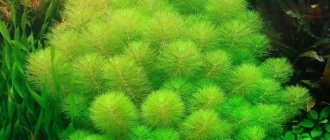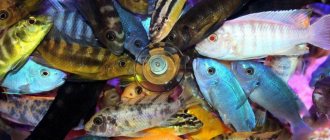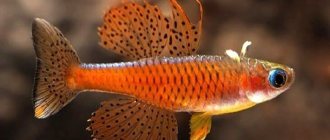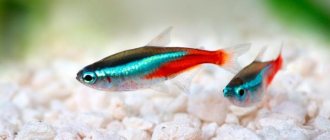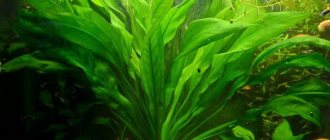Limnophila aromatica is a long-stemmed tropical aquarium plant native to Southeast Asia. While Limnophila aromatica is known throughout the world as an aquarium plant, in Vietnam it is used as a seasoning for dishes, for making tea, and is also used in Thai and Cambodian recipes. Also known as "rice grass". If you rub the leaves in your hands, you can feel a pleasant smell, which is why the plant got its name. Limnophila aromatica also has a pleasant, unique taste.
Origin and description
Limnophila aromatica is native to Southeast Asia and is found in countries such as Vietnam, India and China. In the early 70s it was introduced and distributed in North America.
In its natural habitat it grows in ponds and flooded rice fields, in swampy places, in muddy soil, and in places with high air temperatures.
Limnophila aromatica comes in several varieties and is a variable, long-stemmed aquarium plant with varying leaf colors from green to purple. The stem under water can reach a height of 25-50 cm. The leaves are about 2.5 - 5 cm in length, green above and purple below, and can reach red and even purple color depending on the variety and lighting. It blooms only if the plant is completely immersed in water, with purple flowers in the internodes. The leaves have a scent reminiscent of lemon, nutmeg and curry.
Kinds
There are many varieties of this plant, and they all differ in their appearance and the conditions under which they grow well. The following types are considered the most popular:
Limnophila aquatic (aka royal)
In its homeland (India, Sri Lanka) it is considered an extremely unpleasant weed, which only interferes with work on rice plantations. However, in general, this is a beautiful plant, which is distinguished by its unpretentiousness and high growth rate. It has a long stem (it is large, but rather fragile), from which thin and small green leaves stretch. The roots are poorly developed, since most of the nutrients are supplied through the leaves;
Limnophila sessile-floral
The conditions of detention are similar to the previous species. But it is significantly different in appearance. The stem is also large and thick, but from it grows 5-12 pinnate leaves, not thin. Under good maintenance conditions, blue-white flowers appear;
Limnophila aromatica
It is called so because it has a pleasant smell. Almost identical elongated leaves stretch from the stem in different directions (about green in color. In nature, it is found in wetlands of Africa and Asia;
Vietnam (mini)
It is easy to guess that this name is directly related to the natural environment where this plant was discovered. Appeared on the market just a few years ago. Significantly different from other species, because the bushes do not stretch upward very much. On the contrary, they form strong thickets only 3-4 cm in height. That is, it is a ground cover plant with thin leaves with jagged edges. The main color is green, but in good lighting reddish inclusions appear. Quite a demanding flora that needs bright light and good soil;
Rugosa
Suitable for planting in the middle and foreground. Green, paired, oval-shaped leaves are formed on the stems. The brighter the light, the shorter the internodes. Rugosa is unpretentious to water parameters. It has a powerful root system, through which it mainly feeds;
Indica
It is found in slow-moving rivers and lakes near Australia, Africa and Asia (i.e., the Indian Ocean). The stem stretches up to a height of 50 cm. Long and thin feathery leaves are located on the whorls. In bright light they can be red, in medium light they can be green;
Point bloom
It grows in swampy areas, including rice fields, which is why it is considered a weed. The stem is thick, green, and may have a lilac tint. 3 narrow leaves grow from one whorl. The upper part is green or brownish, the lower part is also green or lilac. The bush reaches a height of 50 cm. It is also unpretentious.
Maintenance and care
Limnophila aromatica is not such a common resident of artificial home ponds. This circumstance is associated, apparently, with some complexity in the content.
Firstly , this fragrant aquatic herb requires intense lighting, at least 1 W per liter.
Secondly , for its growth, fertilizing with carbon dioxide is necessary, possibly in the form of mash.
If these conditions are not met, the foliage gradually falls off, the trunk becomes bare, and the limnophila loses its decorative effect. The same thing can happen if the stems are planted too often.
Vegetation is not particularly demanding on temperature conditions. Normal water for it should be warm, from +22 to +28 degrees. The main thing is that this temperature is stable, without sudden changes.
The grass loves slightly silted soil, where it is necessary to periodically add mineral fertilizers containing micro- and macroelements.
The plant is planted in groups of 3 cuttings in the background, and after planting the grass may not show signs of growth for a long time.
no signs of growth. Intense lighting and CO2 feeding are recommended immediately. Many experts recommend keeping aquarium shrimp with this vegetation.
According to most aquarists, aromatic limnophila is very capricious in its content. But if it has taken root and feels good, it blooms with white flowers and looks quite attractive in the aquatic landscape.
Reproduction
The aquarium plant Limnophila aromatica is propagated by cuttings, although propagation by seeds is also possible. Cut cuttings are planted in the soil at a sufficient distance so that the plants do not shade each other. Regular trimming will result in several new shoots growing from the main trunk, making the bushes quite bushy and much better looking.
Diseases
If the plant has lost its attractive appearance, most likely an error was made in the water parameters or care of the aquarium.
Description of some symptoms characteristic of a diseased limnophila:
- lack of calcium leads to yellow coloring of young leaves;
- an increased level of acidity affects plant growth, ambulia stops growing or grows very slowly;
- dense soil leads to rotting of the root system;
- if the plant has dropped its leaves, it is necessary to check the phosphorus level, most likely it is low;
- insufficient lighting leads to rotting and death of the lower leaves;
- Too small leaves indicate excessive light.
If there is a sudden change in water parameters, the plant may wither and die.
Yellow edging on young leaves is evidence of calcium deficiency
Limnophila aquatic: the secret of popularity
Royal Ambulia is another name for this beautiful underwater grass. Ambulia growing along the edges of reservoirs in India and Sri Lanka can create real underwater jungles. Indian peasants consider it a malicious weed and have been trying to remove it from their rice plantations for many centuries.
A decorative version of ambulia can often be seen in personal and office aquariums; it is a favorite plant of novice aquarists and aqua designers. True, it needs a tall aquarium.
Appearance . The vegetation consists of a long stem from which many thin leaves of a light green color emerge. At the top, the leaves are directed towards the light source. The stem of the grass is quite thick and very fragile, which must be taken into account when planting cuttings. The root system is poorly developed. The fact is that ambulia receives the bulk of its nutrients from the aquatic environment through its leaves.
Soil . Normal soil is small river pebbles or coarse sand. There is no special need for soil feeding.
Reproduction . Despite their fragility and tenderness, the roots can grow well in the soil in a horizontal plane, producing young shoots. By the way, this is also a method of propagation on a par with planting cuttings. But in this case, it is necessary to control the frequency of spread of young shoots, avoiding the creation of continuous thickets.
Water parameters . The acid-base balance and hardness of aquarium water are not particularly important. Cleanliness is much more important, so the aqua must be replaced weekly at a rate of 25%. The optimal temperature for royal ambulia is the range from +22 to +28 degrees. The grass jungle blooms with light blue flowers in favorable conditions. Very beautiful!
Like all limnophiles, Limnophila aquatica needs intense light.
An interesting property: water grass has its own daily routine, and at night it sleeps with its leaves folded closer to the stem.
What is the secret of the popularity of ambulia? Apparently, in a successful combination of such qualities as visual attractiveness, ease of care, availability of reproduction and low price of seedlings. In addition, the thickets of ambulia growing near the back wall of the aquarium are very popular with the fry of many types of ornamental fish.
Despite the apparent similarity in living conditions, each representative of the genus Limnophila has some of its own characteristics. If you take them into account and create an optimal regime for development, each of the limnophiles will reward you not only with attractive underwater thickets, but also with pretty flowers.
Plant varieties
There are several types of limnophila. Among aquarists, the most common species are the following:
Royal limnophila or aquatic amulia. This plant is considered the largest of all species. In India and Vietnam it is considered a weed, but in Europe it is used in aquariums
It is able to absorb nutrients from water and it doesn’t matter to it what kind of soil it is in. It reproduces both by cuttings and with the help of roots - they grow horizontally in the soil itself
An important condition for her is clean water. It grows quickly and after a short period of time a real jungle is formed in the aquarium. If the light is turned off, the plant lowers its leaves down, pressing them closer to the stem. Dwarf limnophila (sessile-flowered). It is highly decorative and is the most undemanding species in terms of conditions and care. Growth is fast and can grow in a wide range of temperatures and hardnesses. It produces horizontal shoots and grows rapidly along the bottom of the aquarium.
- Indian limnphila. The main difference of the plant is its ability to release substances that are toxic to fish into the water when cut. In view of this, such a plant should be trimmed outside the aquarium. Before planting such limnophila, the cuttings should be washed well in water. It is better to plant in large tanks, because the concentration of hazardous substances becomes lower and is no longer so dangerous for the inhabitants of the aquarium. Indian limnophila has the ability to change the color of foliage depending on the light.
- Limnophila rugosa. This plant is very beautiful. It can form an entire lawn, which looks very beautiful in the foreground or background of the aquarium. Good growth is observed in water of medium hardness, the root system is quite powerful. Adding microelements to water has a good effect on growth.
- Limnophila Belem. A very original and elegant variety of limnophila. The foliage is red in color, and its intensity depends on the lighting. When feeding, CO2 grows much faster, especially if the water hardness is increased. Under normal conditions it looks very beautiful. If the lighting is bright, then the color of the plant becomes brighter.
In addition to these, there are other types of limnophils. Among them are Limnophila hippiroides and others.
Limnophila sessile-floral
It has some differences from its fragrant relative.
Conditions of detention.
First of all, there are no such strict requirements for the hardness and temperature of the aquatic environment: Limnophila sessiliflora grows normally and lives at hardness in the range from 2 to 15 degrees and in the temperature range from +18 to +30 degrees Celsius. Even a temporary drop in temperature to +15 degrees will not negatively affect her condition.
Appearance.
This representative of limnophila has a thick stem (up to 6 mm in cross-section), on which from 5 to 12 pinnate leaves grow from each whorl.
Limnophila sessiliflora blooms beautifully. Its flowers are white and blue with small dark specks.
Priming.
Sand is used as it, sometimes with the addition of clay. Special soil feeding is most often not required, since the decay products of organic matter are sufficient for vegetation. But a weekly water change of 20-25% of the total volume must be done. Constant filtration is also necessary.
Under optimal conditions, the plant creates dense, tall thickets (up to 50 cm). Therefore, it must be kept in deep jars with a column height of at least 60 cm. As in the first case, intensive lighting through fluorescent lamps is necessary for growth and normal development.
How to plant?
Sessile-flowering limnophila is planted by cuttings, which are cut from the old stem. Cuttings measuring 15-20 cm are planted in the ground, and after 4-5 days roots begin to appear. By the way, they are very delicate in this vegetation, so when periodically cleaning the soil you need to try not to touch them again.
In general, this representative of the Norichnikov family is less capricious, and caring for her is not particularly difficult. It is not entirely clear why it is not widely popular. Apparently, most aquarists prefer to breed its other relative - Limnophila aquatic, or Ambulia.
JAVA MOSS: CARE, CONTENTS, DESCRIPTION, REPRODUCE, PHOTO
AMBULYA: REPRODUCTION, CONTENTS, DESCRIPTION, PHOTO
PISTIA: DESCRIPTION, CONTENTS, REPRODUCTION, PHOTO, CARE
Nomaphyla serrata
Nomaphyla serrata is much better known to aquarists. Its exact species identity has not yet been established and the plant is listed under the commercial name N.sp. “Densely leafed”.
It differs from the previous species in having wider leaves and a darker color of the leaf blade. A clearly defined serration is visible along the edge of the leaf, which is well preserved in the above-water leaves. The whorls of leaves are located further apart on the stem than in previous species, which affects the decorative qualities of the plant. The conditions of detention are similar to those described above. It is not possible to grow this nomaphyla in soft water for a long time, as it begins to shrink and shed old leaves.
The tops of the plant gradually die, but the stems remain for quite a long time, but growth does not resume. In a tropical aquarium in water of medium hardness with sufficient lighting, this nomaphyla develops quite satisfactorily, but it is not at all interesting when exposed to air. Therefore, its stems that have reached the surface of the water must be cut - then the plant bushes and forms many shoots at the base of the stem. In some cases, long stems are pressed to the ground, but in this case the top grows the fastest, and there is almost no tillering. This nomaphyla, like other species, is propagated by cuttings.

